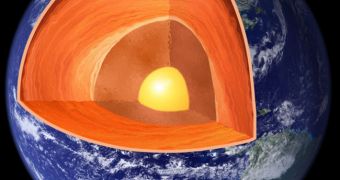Heat emanating from within our planet is responsible for moving continents, generating new landmasses, destroying tectonic plates, and allowing for the existence of a defensive shield in the atmosphere. Now, a team of experts takes a closer look at Earth's primary heat source.
In past investigations, geologists dug a total of 20,000 boreholes, which took their equipment further down into the ground than they've ever been. Measurements conducted under these extreme conditions revealed the amount of heat our planet throws into space.
Experts say that more than 44 trillion watts (terawatts) of heat are flowing continuously from Earth. Scientists working for the Kamioka Liquid-scintillator Antineutrino Detector (KamLAND) recently took it upon themselves to tease out the exact origin of the heat.
It has been known for quite some time that the natural decay of elements such as thorium, uranium and potassium are responsible for heating up both the Earth's mantle and crust. The international KamLAND collaboration, which is based in Japan, showed that this contribution can be measured directly in 2005.
The way to do that – assess the exact proportion to which each chemical produced heat – experts turned to searching for geo-antineutrinos, which are elementary particles that are produced whenever radioactive isotopes begin to decay.
“As a detector of geoneutrinos, KamLAND has distinct advantages,” explains Stuart Freedman, who is the leader of the US participation effort in KamLAND. He holds an appointment as a professor in the University of California in Berkeley (UCB) Department of Physics.
The investigator holds holds an appointment with the Nuclear Science Division (NSD) at the US Department of Energy's (DOE) Lawrence Berkeley National Laboratory (Berkeley Lab).
“KamLAND was specifically designed to study antineutrinos. We are able to discriminate them from background noise and detect them with very high sensitivity,” the expert goes on to say.
In the latest study to be produced by the collaboration, experts improve on past measurements, and determine that radioactive decay provides about 50 percent of all of our planet's heat. These results are more than 97 percent certain.
These results are not only consistent with theoretical prediction, but are now certain enough to allow experts to modify the theory according to reality.
“One thing we can say with near certainty is that radioactive decay alone is not enough to account for Earth’s heat energy. Whether the rest is primordial heat or comes from some other source is an unanswered question,” Freedman explains.
“This is what’s called an inverse problem, where you have a lot of information but also a lot of complicated inputs and variables. Sorting those out to arrive at the best explanation among many requires multiple sources of data,” he adds.
Details of the research appear in a paper entitled “Partial radiogenic heat model for Earth revealed by geoneutrino measurements,” which appears in the latest advanced online issue of the top journal Nature Geoscience. The study will also be published in print soon.

 14 DAY TRIAL //
14 DAY TRIAL //